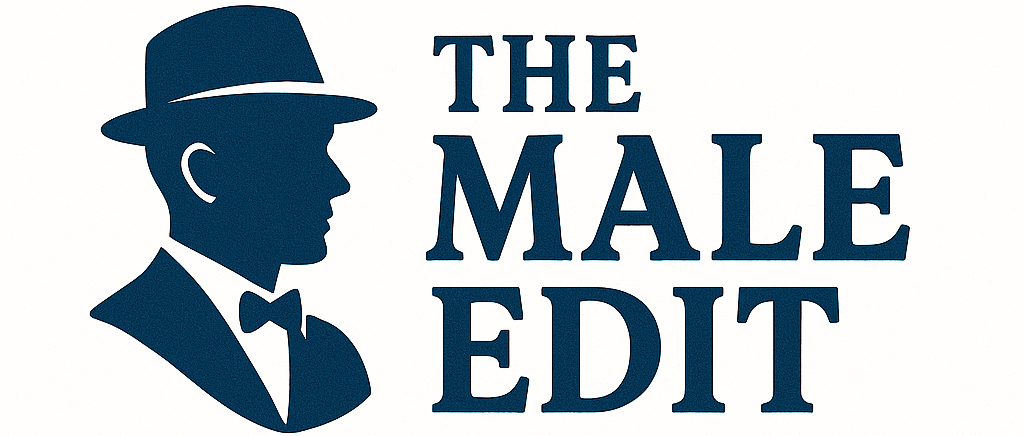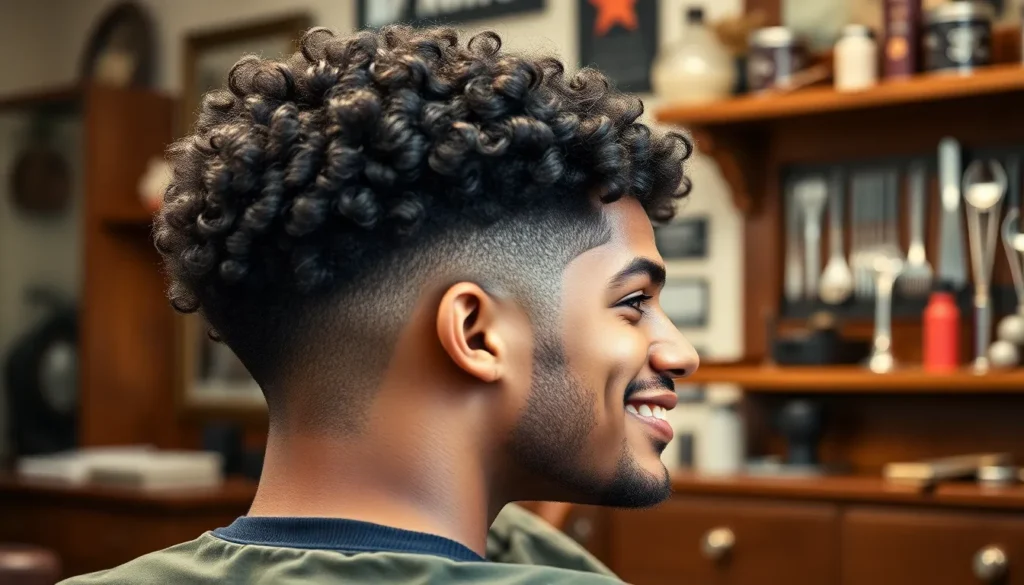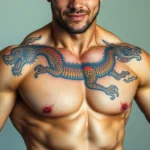Curly hair can be your greatest asset or your biggest styling challenge – it all comes down to the right cut. We’ve seen countless men struggle with their natural texture simply because they haven’t found the perfect haircut that works with their curls instead of against them.
The truth is most barbers don’t understand how to cut curly hair properly. They apply straight-hair techniques to textured locks resulting in unflattering shapes triangular silhouettes and endless bad hair days. But when you find the right cut for your curl pattern everything changes.
We’re here to transform your relationship with your curls. From understanding your exact curl type to discovering cuts that enhance your natural texture we’ll show you how to turn your curly hair into your signature look. Whether you’re dealing with loose waves or tight coils the perfect men’s haircut is waiting to unlock your hair’s full potential.
The Classic Curly Undercut
This popular style combines the best of modern barbering with curl-friendly techniques, giving men a sharp contrast between tamed sides and natural texture on top.
Short Sides with Curly Top Volume
Create dramatic contrast by asking your barber to fade the sides to a #2 or #3 guard while leaving 3-4 inches of length on top. The undercut works especially well for men with type 2B to 3B curls because it removes bulk from the sides where curls often become unruly.
Request a gradual fade rather than a harsh line to ensure the transition looks natural with your curl pattern. We recommend starting the fade at temple level and blending upward to maintain proportion with your face shape.
Maintain the crown area with enough length to showcase your natural curl formation. The top section should be at least 2 inches longer than the sides to create the signature undercut silhouette that frames your features.
Consider your curl density when determining how short to go on the sides. Men with thick, coarse curls can handle shorter sides (down to a #1), while those with fine curls should stick to a #2 or #3 to avoid creating too stark a contrast.
Styling Tips for Maximum Definition
Apply curl cream to damp hair using the “praying hands” method to distribute product evenly without disrupting your natural curl pattern. Start with a quarter-sized amount and add more as needed.
Scrunch upward while your hair is still wet to encourage curl formation and remove excess water. This technique helps define individual curls while maintaining volume at the roots.
Use a microfiber towel or cotton t-shirt to gently squeeze out moisture instead of rubbing with a regular towel. Traditional towels create frizz by roughing up the hair cuticle.
Diffuse on low heat if you’re using a blow dryer, keeping the diffuser attachment at least 6 inches away from your scalp. Move the diffuser in circular motions to prevent flattening the curls on top.
Refresh between washes by misting your hair with water mixed with a small amount of leave-in conditioner. Scrunch the mixture into your curls to reactivate the styling products and restore definition.
The Modern Curly Fade
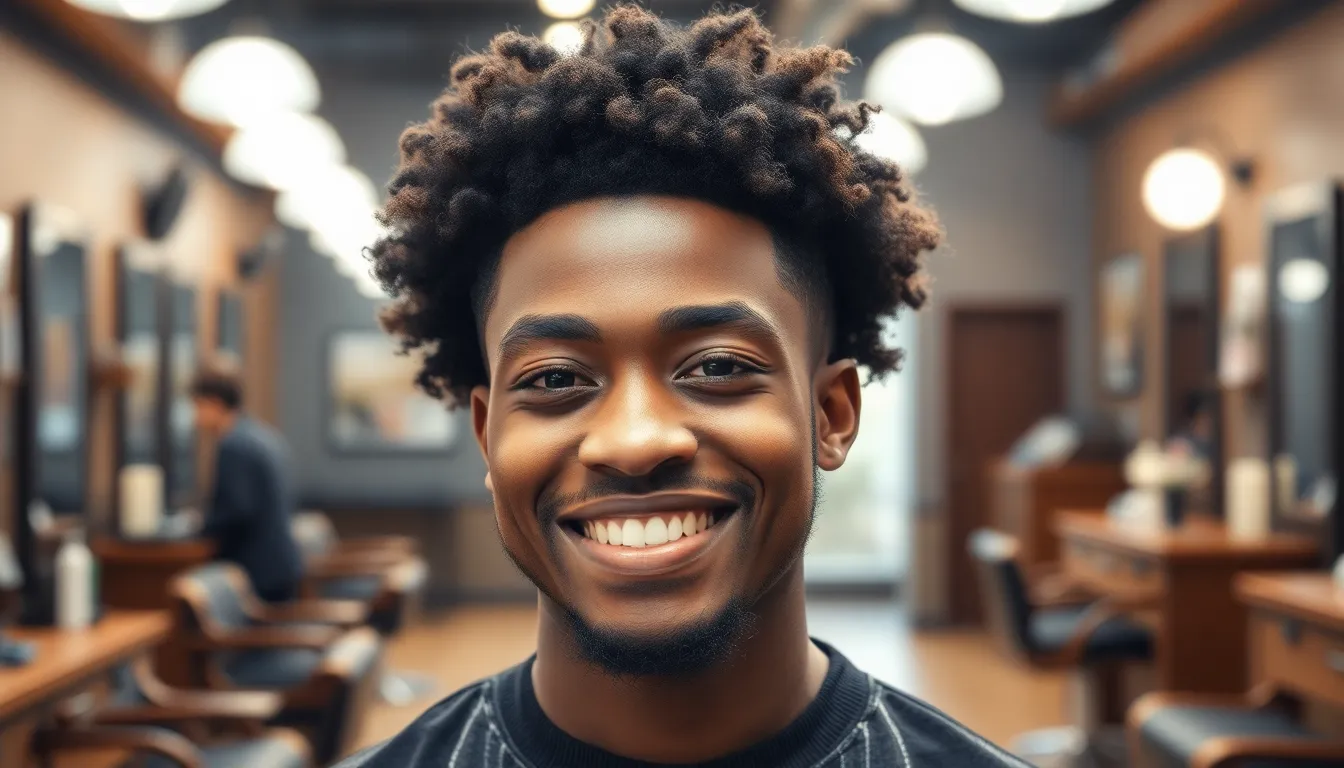
Building on the classic undercut foundation, the modern curly fade takes curl friendly barbering to the next level. We’ve seen this style revolutionize how men approach curly hair, blending sharp precision with natural texture to create a contemporary look that works for virtually any curl type.
High Fade Variations
High fades for curly hair start dramatically above the temples, creating maximum contrast between your natural curls and clean sides. We recommend this technique for men with dense, voluminous curls who want to showcase their texture on top while maintaining a sharp professional appearance.
Clipper techniques involve starting with longer guards and gradually working down to skin level, using open and closed lever positions to eliminate harsh lines. Your barber should pay special attention to blending around the temples where curls meet the fade line.
Best curl types for high fades include 3A to 3C curls with good density, as the dramatic contrast highlights the curl pattern beautifully. Looser curls might appear flat against the stark fade line, while tighter coils can create an striking silhouette.
Styling approach requires curl cream applied to damp hair, followed by scrunching motions to enhance definition. Air drying works best to maintain volume, though you can use a diffuser on low heat if you’re pressed for time.
Mid Fade Options
Mid fades offer the perfect balance between dramatic and subtle, starting just above the ears to create moderate contrast. We find this option works exceptionally well for professional environments where you want style without being too bold.
Blending techniques require multiple guidelines to ensure evenness and symmetry across both sides of your head. Your barber should repeatedly go over fade lines with different clipper guards, adjusting lever positions for seamless transitions into your curls.
Versatility factors make mid fades ideal for various face shapes and curl patterns. Men with 2C to 3B curls particularly benefit from this approach, as it maintains enough side volume to complement facial structure while keeping things neat.
Maintenance schedule typically involves touch ups every 2 to 3 weeks to keep the fade looking sharp. Between visits, you can refresh your curls with a mixture of water and leave in conditioner to reactivate your styling products.
Low Fade Techniques
Low fades start subtly near the neckline and ears, creating the most conservative fade option while still delivering that clean, modern aesthetic. We recommend this technique for men who want to ease into the fade trend or work in traditional professional settings.
Tapering methods begin at the bottom using small, steady clipper strokes combined with blending shears for smooth transitions. The key lies in maintaining most of your natural curl texture on the sides while creating definition around the hairline.
Curl preservation becomes the primary focus with low fades, as you’re keeping more of your natural length throughout the sides and back. This approach works particularly well for men with 2A to 3A curls who want structure without sacrificing their curl pattern.
Professional appeal makes low fades perfect for conservative workplaces or formal occasions. The subtle nature of this fade allows your curls to remain the focal point while adding just enough structure to appear polished and intentional.
The Textured Curly Quiff

The Textured Curly Quiff elevates natural curl patterns into a sophisticated style that commands attention. This versatile cut transforms everyday curls into a statement look that works for both professional and casual settings.
Creating Height and Movement
Layering techniques form the foundation of this ever-changing style. Point cutting methods enhance your natural curl pattern while adding essential texture throughout the hair. Professional barbers use these specialized techniques to create separation between individual curls, allowing each one to define itself naturally.
Cutting curly hair dry becomes crucial for achieving the perfect quiff shape. We recommend this approach because it reveals how your curls naturally fall and bounce, ensuring the final cut maintains your hair’s authentic movement. Dry cutting prevents the common mistake of over cutting curls that appear longer when wet.
Razor techniques add the finishing touches that make this style truly exceptional. Skilled barbers use razors to create layered effects that encourage curl separation and movement. These methods help individual curls maintain their natural spring while contributing to the overall textured appearance.
Understanding your exact curl pattern allows for customized cutting approaches. Type 2A waves require different layering than Type 3C coils, and experienced stylists adjust their techniques accordingly. Dampening hair slightly during the cutting process makes it more manageable without compromising the curl’s natural shape.
Product Recommendations for Hold
Curl defining creams provide the perfect foundation for styling the Textured Curly Quiff. These lightweight formulas enhance your natural curl pattern without creating unwanted weight or stiffness. We recommend applying these products to damp hair for optimal absorption and curl formation.
Matte paste delivers additional texture and hold when applied strategically to damp hair. A small amount distributed through the mid lengths and ends helps define individual curls while maintaining the style’s natural movement. This product works particularly well for creating the quiff’s signature height and shape.
Leave in conditioners become essential for managing longer curly hair within this style. These products help control frizz while maintaining necessary moisture levels throughout the day. Regular use prevents the dryness that can make curls appear lackluster and difficult to style.
Styling techniques maximize product effectiveness when creating your textured quiff. Using fingers or a wide tooth comb allows curls to form naturally without excessive manipulation. Avoid brushing or combing once the hair is dry, as this disrupts the curl pattern and can create unwanted frizz.
The Curly Pompadour

The curly pompadour transforms traditional styling with modern flair, combining upward movement with natural curl texture. We’ve found this versatile cut works exceptionally well for men seeking sophisticated elegance without sacrificing their natural curl pattern.
Vintage-Inspired Styling Approach
Longer layered cuts form the foundation of our vintage inspired curly pompadour approach. We recommend embracing natural curl movement through strategic layering that allows each curl to flow freely while maintaining the pompadour’s signature height.
Point cutting techniques preserve curl integrity throughout the styling process. Our barbers focus on cutting methods that prevent frizz formation while encouraging natural curl definition. The technique involves cutting into the hair at various angles, creating texture that enhances rather than disrupts your curl pattern.
Natural texture takes center stage with this effortless styling method. We suggest working with your curls’ natural direction rather than forcing them into unnatural positions. The vintage approach celebrates authentic curl movement while achieving the pompadour’s classic silhouette through careful product application and gentle manipulation.
Maintaining Shape Throughout the Day
Dampening hair creates the perfect foundation for curly pompadour styling success. We start each styling session by lightly misting curls with water, which makes them more pliable and responsive to product application.
Curl defining creams become essential tools for maintaining pompadour structure without compromising natural texture. We apply lightweight gels sparingly to enhance curl definition while reducing unwanted frizz throughout the day. The key lies in using just enough product to provide hold without weighing down your curls or creating stiffness.
Heat styling tools should remain minimal in your curly pompadour routine. We recommend air drying whenever possible to preserve your natural curl pattern and prevent damage that can disrupt the pompadour’s shape. Diffusing on low heat settings offers a compromise when time constraints require faster drying methods.
Product layering techniques help extend your pompadour’s longevity from morning to evening. We suggest applying a leave in conditioner first, followed by curl cream, and finishing with a light hold gel for maximum shape retention without sacrificing curl movement.
The Natural Curly Shag
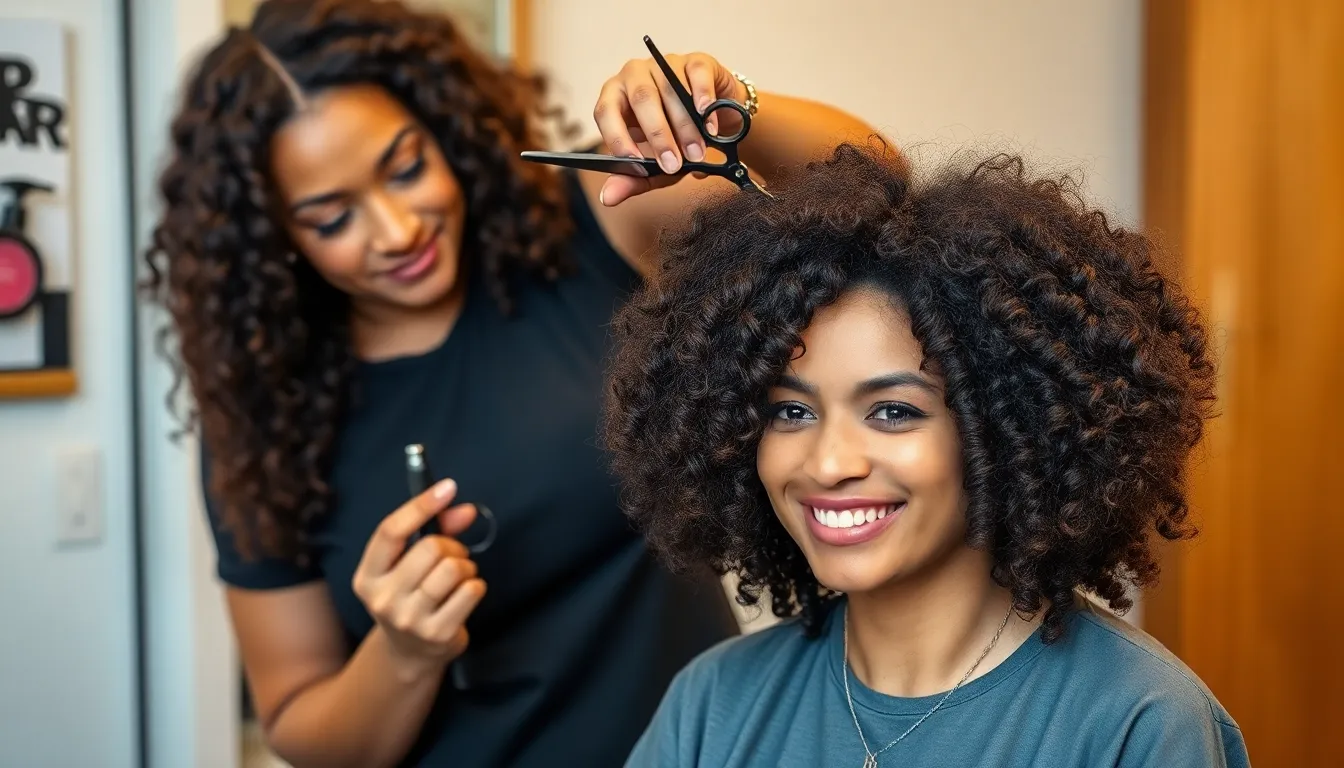
The Natural Curly Shag transforms your curls into a effortlessly stylish statement that celebrates texture over restraint. We’ve mastered this technique by cutting damp hair to better manage curls and enhance their natural movement.
Embracing Your Curl Pattern
Working with your natural curl pattern forms the foundation of any successful curly shag. We recommend identifying your exact curl type before selecting products that define curls without adding weight. Curl defining creams and lightweight mousses enhance your natural texture while maintaining bounce and movement.
Air drying becomes your best friend when styling a curly shag. We suggest using a diffuser attachment with cool air settings to preserve curl integrity and minimize frizz. Scrunching techniques help activate your natural curl pattern while products are still damp.
Understanding your curl’s unique characteristics allows us to customize the cutting approach. Dense curls benefit from more aggressive layering while fine curls need careful consideration to maintain volume. Each curl pattern responds differently to styling methods and product application.
Layering Techniques for Volume
Strategic layering creates the signature volume that defines a curly shag. We use thinning shears to blend different curl lengths seamlessly throughout the cut. Round graduation combined with square layers enhances both volume and texture in curly hair.
Point cutting becomes essential when working with curly textures. This technique preserves the natural curl formation while removing bulk in targeted areas. We cut into the hair at various angles to encourage curl separation and movement.
Blending different curl lengths requires exact barbering expertise. Professional stylists use these techniques to create seamless transitions between layers. The result showcases your curls’ natural beauty while maintaining a polished appearance.
Volume distribution throughout the cut ensures balanced proportions. We focus on removing weight from areas that would otherwise flatten your curls. This approach allows each curl to move independently while contributing to the overall shape.
The Curly Buzz Cut
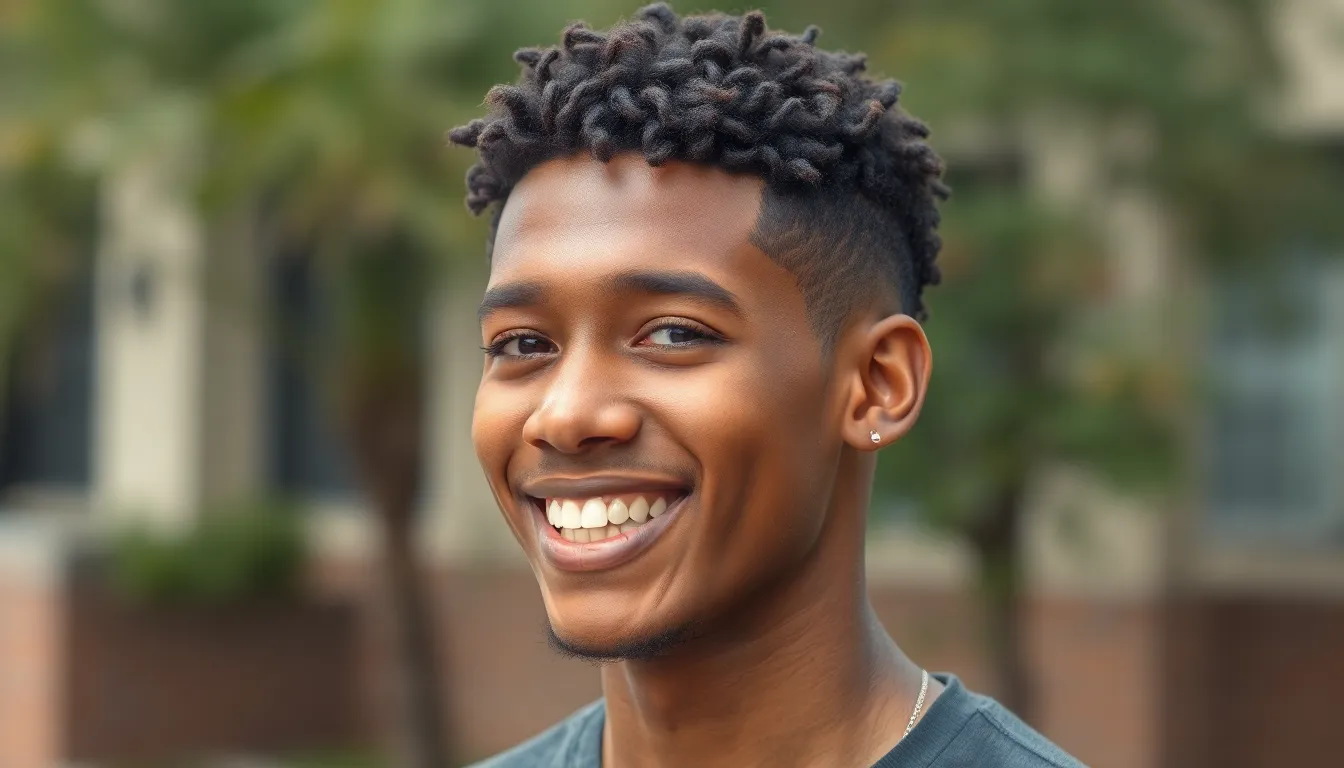
We’ve explored sophisticated styling options, but sometimes the boldest choice is embracing simplicity. The curly buzz cut delivers maximum impact with minimal effort by clipping hair very close to the scalp while allowing natural curl texture to create visual interest.
Ultra-Low Maintenance Option
Styling becomes effortless when you choose a curly buzz cut since it requires almost no daily routine or product application. Morning preparation takes seconds instead of the lengthy styling sessions other curly cuts demand. Heat retention decreases significantly with shorter lengths, making this cut ideal for active lifestyles and warmer climates where comfort matters most.
Time savings multiply because home maintenance becomes simple with basic clippers, reducing frequent barber visits. Tangling disappears entirely when hair stays this short, eliminating the frustration of knots and matting that longer curls experience. Product costs drop since you’ll need minimal styling products to maintain this clean, natural look.
Versatility remains high even though the minimal length because barbers can add fades or sharp lines for extra style without increasing daily upkeep requirements.
Best Curl Types for This Style
Tight curls and coils perform exceptionally well with buzz cuts because short clipping emphasizes natural texture without creating unwanted bulk or weight. Dense, thick hair benefits most from this approach since buzz cuts help reduce overwhelming volume while creating a neat, controlled silhouette.
| Curl Pattern | Buzz Cut Compatibility | Visual Result |
|---|---|---|
| 3B to 4C | Excellent | Defined texture at short lengths |
| 2C to 3A | Good with longer guards | Subtle curl definition |
| 2A to 2B | Limited texture visibility | Best with faded variations |
Curl patterns from 3B to 4C retain defined texture even at extremely short lengths, making the cut visually interesting and ever-changing. Looser curl types require strategic adjustments like slightly longer clipper guards on top or graduated fades to maintain visible curl definition.
Coarser hair textures showcase the buzz cut’s natural appeal by creating subtle shadows and dimension through varied curl directions. Fine curly hair still works with this style but may need longer lengths on top to prevent appearing too sparse or flat.
The Side-Swept Curly Style

Moving beyond traditional curly cuts, we’re exploring a sophisticated approach that combines asymmetrical appeal with natural curl movement. The side-swept curly style transforms your natural texture into a polished, directional look that frames your face beautifully.
Creating Asymmetrical Balance
Balance starts with strategic length distribution across your head. We cut and layer hair at exact angles, focusing on creating more volume or length on one preferred side. Your barber will leave the hair longer on your chosen side to sweep gracefully across your forehead or temple area.
Tapering creates the essential contrast that makes this style work. The opposite side gets clipped closer to the head or receives a shorter taper, establishing visual interest that emphasizes your facial features. This technique preserves your curl pattern while creating that coveted asymmetrical effect.
Point cutting becomes crucial for maintaining curl separation and movement. We use this finishing technique on the ends to encourage your curls to fall naturally without disrupting their bounce. The objective involves allowing curls to cascade naturally to one side, creating an effortless yet intentional appearance.
Careful layering prevents the bulky, uneven look that can plague curly styles. Your stylist will work with your hair’s natural bounce, ensuring each curl contributes to the overall shape without overwhelming the design.
Tools for Proper Sectioning
Precision sectioning makes the difference between amateur and professional results. We rely on exact tools to create clean divisions that respect your curl pattern while achieving even length distribution.
| Tool Category | Exact Tools | Primary Function |
|---|---|---|
| Sectioning | Clips and sectioning clips | Separate hair into manageable cutting parts |
| Combing | Fine and wide tooth barber combs | Detangle and create clean sections |
| Cutting | Barber scissors and thinning shears | Slice and point cut for texture and shape |
| Optional Tools | Razor or clippers with guards | Taper or undercut exact areas |
| Preparation | Spray bottle | Lightly dampen hair for better control |
Sectioning clips become your barber’s best friend during this process. They separate your hair into manageable parts, allowing for precise cutting that maintains consistency throughout your head. Each section gets individual attention to ensure your curls fall exactly where they should.
Barber combs with varying teeth widths handle different curl densities effectively. Fine teeth work through tighter curl patterns, while wide teeth manage looser curls without causing breakage or frizz during the cutting process.
Spray bottles provide the light moisture control that curly hair demands. We dampen your hair slightly before cutting, giving your barber better control over curl placement without fully saturating the strands.
The Curly Mohawk
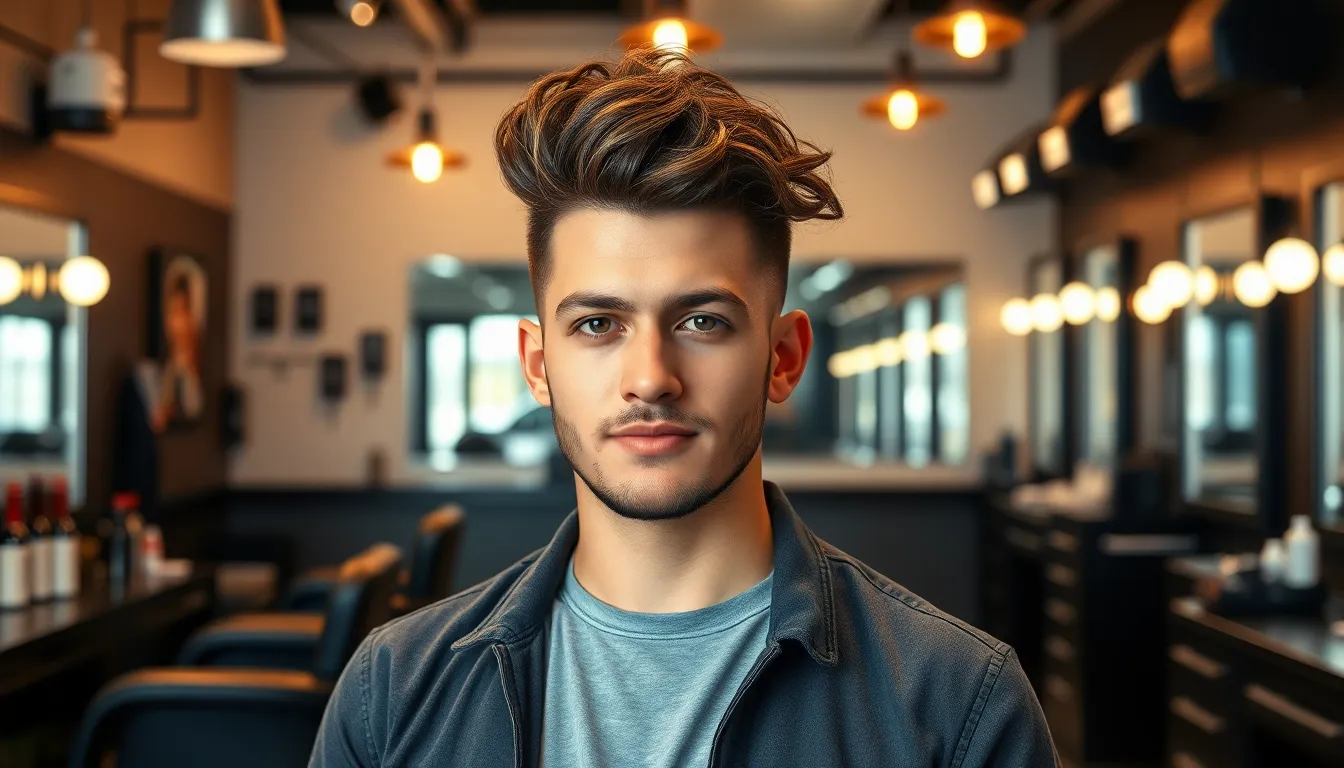
The Curly Mohawk transforms traditional punk aesthetics into sophisticated styling that celebrates natural curl texture. This bold cut creates maximum impact by contrasting closely trimmed sides with voluminous curly tops.
Bold Statement Styling
Curly Undercut variations dominate the foundation of mohawk styling, featuring sides cut very short while preserving length on top. This dramatic contrast allows tightly coiled curls to become the focal point, creating visual impact that works especially well with dense curl patterns.
Curly Man-Bun combinations offer versatility for longer curly hair by gathering the mohawk’s top section into a structured bun. Modern variations pair this gathering technique with fade or undercut sides, creating a contemporary look that maintains the mohawk’s edgy appeal while offering professional styling options.
Curly Mid Fade integration blends the mohawk’s sharp lines with gradual transitions, making this bold style more versatile for various face shapes. The fade softens the dramatic contrast while still accentuating facial features, allowing the curls on top to create height and movement that defines the mohawk’s signature silhouette.
Styling product application becomes crucial for maintaining the mohawk’s shape throughout the day. Curl defining creams work best when applied to damp hair, while matte paste provides hold without weighing down the curls, ensuring the top section maintains its dramatic height and texture.
Gradual Transition Techniques
Curl pattern assessment forms the foundation of successful mohawk cutting, requiring barbers to understand how each client’s exact curl type will behave when dramatically shortened on the sides. Tightly coiled curls create the most striking contrast, while looser curl patterns may need adjusted proportions to achieve the desired visual impact.
Dry cutting methods prove essential for mohawk precision since wet curls appear longer and may mislead the cutting process. Cutting curly hair in its natural dry state allows barbers to see exactly how the curls will lie, ensuring accurate length distribution between the dramatic sides and voluminous top.
Point cutting applications enhance the natural curl pattern while reducing bulk that could interfere with the mohawk’s clean lines. This angled cutting technique works particularly well on the transition areas where the short sides meet the longer top, creating seamless blending that prevents harsh demarcation lines.
Damp hair preparation with styling products makes longer curly sections more manageable during the cutting process, especially when shaping the mohawk’s top portion. Light misting combined with curl cream allows barbers to see the hair’s natural movement while maintaining enough control for precise cutting along the mohawk’s defining edges.
The Long Curly Layered Cut
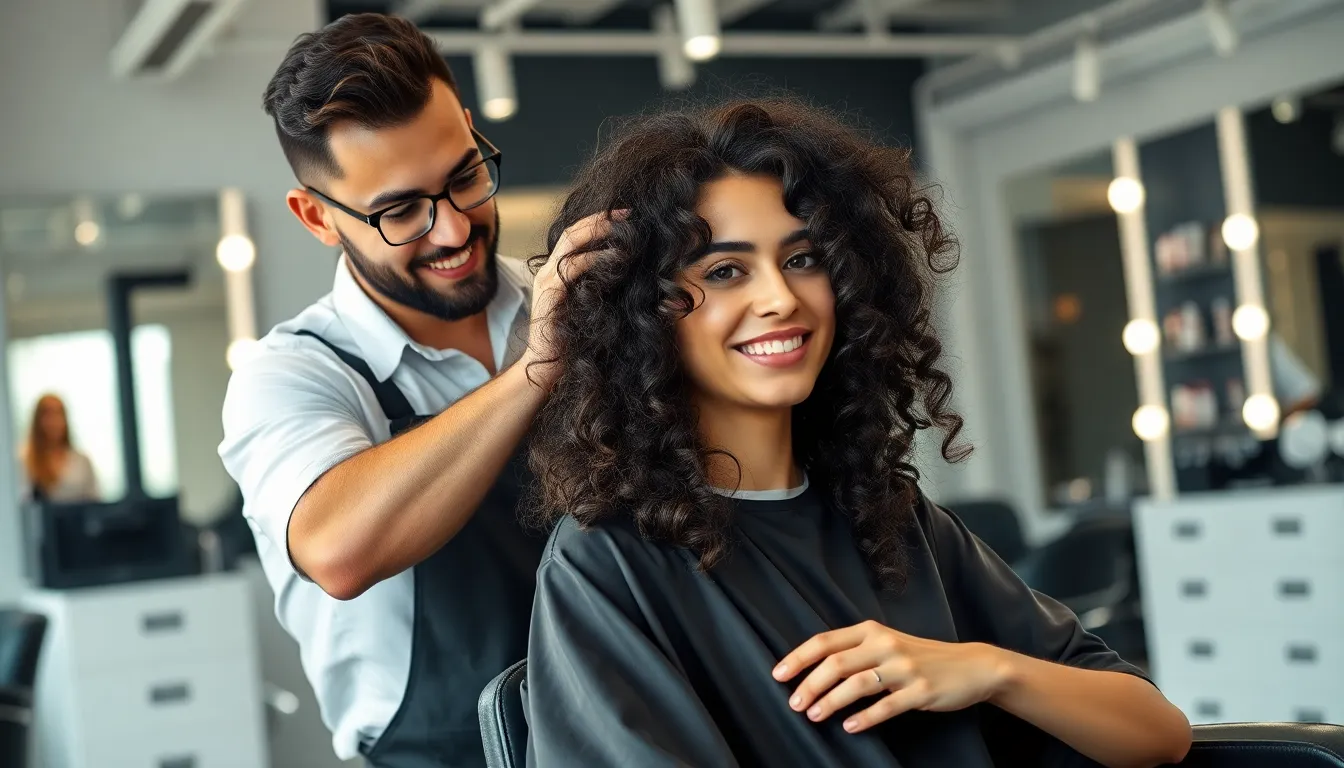
The Long Curly Layered Cut transforms natural curl patterns into defined, manageable styles that enhance volume while maintaining length. This technique strategically reduces bulk through layering, preventing curls from forming undesirable pyramid shapes that occur when hair becomes heavy at the bottom.
Managing Length and Weight
Dry cutting techniques provide the most accurate results for curly hair, allowing stylists to visualize how each curl will naturally fall and form. We recommend cutting curly hair when it’s completely dry or only slightly dampened rather than soaking wet to achieve the best final shape. Wet cutting can mislead stylists about the true length since curls spring up significantly after drying, often resulting in shorter than expected outcomes.
Strategic layering removes excess weight while preserving curl integrity throughout different sections of the head. Each layer gets cut at varying lengths to prevent the bottom heavy appearance that makes curls look triangular. Professional stylists use this method to create distinct curl shapes rather than allowing them to mass together into one bulky section.
Weight distribution becomes crucial when working with longer curly hair that tends to pull down from its own mass. Proper layering techniques ensure that curls maintain their natural bounce and movement without becoming weighed down. This approach allows men to keep their desired length while achieving better curl definition and manageability.
Preventing Triangle-Shaped Hair
Point cutting techniques eliminate the triangle effect by cutting hair ends at angles rather than straight across, which promotes better curl separation and reduces bulk. This method prevents the wider base appearance that occurs when sides and top sections are shorter than the bottom layer. Round graduation and square layer techniques add strategic volume in the crown area while thinning out excess strands for balanced proportions.
Crown and back layer management requires keeping these sections shorter than the sides when necessary, depending on individual curl patterns and density. Triangle shapes develop when the hair’s widest point sits at the bottom rather than creating an even silhouette from top to bottom. We achieve better balance by adjusting layer lengths to complement each person’s exact curl characteristics.
Regular maintenance schedules help prevent the gradual return of triangle shaped hair as curls grow out and regain weight. Most men with long curly layered cuts benefit from trims every 6 to 8 weeks to maintain their desired shape. Using appropriate styling products between cuts keeps curls defined and manageable while preserving the layered structure that prevents unwanted bulk accumulation.
The Curly Caesar Cut

The Curly Caesar Cut adapts the classic Caesar style specifically for men with tight curls, offering a sophisticated look that’s both professional and effortlessly cool. This modern interpretation keeps curls short while maintaining their natural texture and definition.
Structured Curl Control
Structured curl control transforms unruly curls into a polished, manageable style through strategic layering and blending techniques. Barbers use thinning shears to create seamless transitions between different curl lengths, ensuring the hairstyle remains balanced and visually appealing without compromising volume or definition.
Length typically ranges from half an inch to two inches, with the horizontal fringe adding structure and a clean appearance. The key lies in experimenting with texture until we achieve the desired result while preserving the natural curl pattern.
Lightweight curl creams or mousse work best for maintaining this structured look. We recommend applying these products to damp hair, followed by air drying or diffusing with cool air for added volume and bounce. This approach helps define curls without weighing them down or creating unwanted frizz.
Professional Styling Methods
Professional stylists employ a systematic approach when creating the Curly Caesar Cut, starting with dampening the hair for better manageability. Wide-toothed combs help detangle curls gently without disrupting their natural formation or causing breakage.
Barbers methodically work around the head from top to bottom, using short strokes against the curl pattern for maximum precision. Clipper cutting, scissor over comb, and round graduation techniques are commonly employed depending on the individual’s curl type and desired outcome.
The horizontal fringe requires special attention to maintain curl shape and minimize frizz. Stylists focus on preserving the natural curl pattern while creating clean lines that enhance facial features. This technique ensures the haircut is customized to each person’s unique curl characteristics.
Regular maintenance every 6 to 8 weeks keeps the Curly Caesar Cut looking sharp and prevents split ends that can compromise curl definition. These frequent trims promote healthy hair growth while maintaining the style’s characteristic clean appearance.
Conclusion
We’ve explored how the right haircut can transform your relationship with curly hair from daily struggle to signature style. Each technique we’ve covered respects your natural curl pattern while delivering the polished look you’re seeking.
Remember that working with your curls rather than against them is the key to achieving lasting results. Whether you choose a bold mohawk or a professional caesar cut your success depends on finding a skilled barber who understands curly hair cutting techniques.
Your curls are unique and deserve a haircut that celebrates their natural beauty while fitting your lifestyle. Take these insights to your next barber appointment and experience the confidence that comes with a perfectly customized curly haircut.
Frequently Asked Questions
What makes curly hair different from straight hair when getting a haircut?
Curly hair requires specialized cutting techniques because it behaves differently than straight hair. Traditional barbering methods designed for straight hair can create unflattering results on curls. Curly hair needs techniques like point cutting, dry cutting, and understanding curl patterns to enhance natural texture rather than fighting against it.
How do I know which curly haircut suits my curl type?
Your curl type determines the best haircut options. Tight curls work well with buzz cuts and Caesar styles, while looser curls suit quiffs and pompadours. Consider your curl density, pattern, and lifestyle needs. Consult with a barber experienced in curly hair to match your specific curl characteristics with the right cut.
What’s the difference between a curly undercut and a curly fade?
A curly undercut features distinct contrast between short sides and longer curly top with a clear line of demarcation. A curly fade creates gradual blending from short to long, offering high, mid, or low fade options. Fades provide more versatility and can be tailored to professional or casual settings.
How often should I trim my curly hair to maintain the style?
Most curly hairstyles require maintenance every 6-8 weeks to keep their shape and prevent bulk buildup. Shorter styles like buzz cuts or Caesar cuts may need trimming every 4-6 weeks, while longer layered cuts can go 8-10 weeks between appointments depending on growth rate and desired look.
What products work best for styling curly hair after a fresh cut?
Use curl-defining creams, lightweight mousse, or matte paste depending on your style. Avoid heavy products that weigh curls down. Apply products to damp hair using scrunching techniques, then air dry or use a diffuser. Layer products for optimal hold while maintaining natural curl movement and definition.
Can I style curly hair differently for professional versus casual settings?
Yes, many curly cuts offer versatility. Mid fades and textured quiffs work well in professional environments, while you can style the same cut more relaxed for casual settings. Adjust product application and styling techniques – use more structured products for work and lighter, more natural styling for everyday wear.
What should I avoid when cutting curly hair?
Avoid cutting curly hair when wet (except for specific techniques), using thinning shears excessively, creating blunt cuts, or following straight-hair cutting methods. Don’t fight your natural curl pattern or try to make curls behave like straight hair. Work with your curls’ natural movement and texture instead.
How do I prevent the dreaded triangle shape with long curly hair?
Prevent triangle shape through strategic layering and weight removal. Use point cutting techniques to create movement and prevent bulk buildup at the bottom. Focus on adding layers around the crown and mid-lengths while maintaining length. Regular trims help manage weight distribution and keep curls bouncy.
